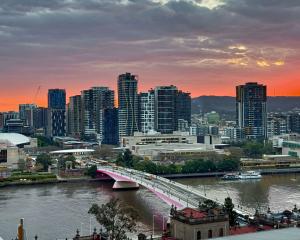ODT reporter Sarah Marquet blogs about life in Seoul, Korea. With funding from the Asia New Zealand foundation, she is working in the newsrooms of one of South Korea's largest papers, the Joong Ang Daily, for six weeks.
Pictures of food and people adorn the guardrails of Seoul's Mapo Bridge, interspersed by phrases and questions such as "have you eaten?", and "think of the faces of your family".

On one side, about halfway across, there is a bronze sculpture of an old man showing affection by pinching a younger man's cheek.
There are also two telephones, an SOS button and plaques proclaiming it to be the "Bridge of Life".
Why?
Because two years ago it was commonly called "suicide bridge".
These installations were the Seoul City Government's way of trying to combat the issue, rather than installing high fences.
According to various media reports, city officials didn't want a "bandaid". They wanted a new solution.
South Korea has the highest suicide rate in the OECD, a rate that has doubled in the last 20 years or so to an average of 43 a day.
According to Statistics Korea, it is the number one cause of death of people in their 20s and 30s, and more than two-thirds of those people are male.
Though it is not the leading cause of death in older people, it is prevalent in that age bracket.
With input from mental health professionals and funding from Samsung, the city government unveiled the installations in September last year.
From one end of the bridge, the messages start with questions such as "how are you?" "have you eaten?" and phrases such as "it's nice to walk along a bridge".
There is a wooden, covered rest area where you can sit and look out over the river, an often hazy view, as cars speed by behind you.
Then, pictures of various Korean foods. "Which is your favourite?" the bridge asks before apologising for the food not being real.
As you approach the first telephone, the questioning changes tack: "Do you have a secret? Now, how about you get it off your chest?" Then, a phone linked to a 24-hour counselling line.
Further along, installations on the bridge talk about the weather and show more pictures, this time of happy looking people.
"Think of the faces of your family . . . their nose . . .their eyes . . .
"Isn't there someone who is missing you right now?
"What about going to see them, rather than just thinking about them."
I have been unable to find information about whether the rate at this bridge has declined since the messages, pictures, sculpture and phones were installed, but there has been some criticism -- specifically that if someone is depressed because they have lost a family member, seeing pictures and messages about family may make them more depressed.
As for causes, there is a lot of speculation. It seems almost impossible to pinpoint a reason.
Some of the suggested causes are:
- Intense pressure put on people to succeed at school and work in a highly competitive culture.There is a pretty high youth unemployment rate in South Korea and so it is important to get good grades and go to a good university. For men, it is especially important to get a good job in order to support their family, as Korean custom dictates a man should do.
- Mental illness, stress and trouble communicating in a "face saving" culture. These topics are still relatively taboo in Korean society where everyone wants to fit in, no one wants to break the mould and people are scared of being stigmatised.
- Financial loss and/or unemployment.
- Late industrialisation clashing with traditional culture.
Since the 1960s, South Korea has gone from one of the poorest nations on earth to one of the richest (in terms of GDP). In the 80s, as the country continued to industrialise, it had one of the lowest rates. There was work available and job security was pretty good.
Then the 1997 Asian Financial Crisis hit and many people lost their jobs. Men, whose traditional role it was to support their families, suddenly found themselves unable to do so.
The suicide rate skyrocketed. Some have speculated that the rapid industrialisation, combined with traditional values put huge amounts of stress on people.
Another factor of rapid industrialisation is that grown children have found themselves increasingly unable to support their elderly parents as tradition dictates.
Some, including The New York Times, use that to explain the high rate among the elderly -- they feel like they might be a burden on their family.
Traditionally, parents do everything they can to help their children get ahead in life. In recent years that includes draining their banks accounts and spending their life savings to get their children the best education possible or to help them buy their first home. The idea is that, in their later years, they will live with and be taken care of by their children.
Now, in the days of high unemployment and tiny apartments, that is becoming harder to do.
There is a pension fund but it is relatively new (was set up in the 80s) and to get it, a person has to prove their children can't or won't support them which might be hard to do in a culture that is all about saving face.
* For support or information about suicide prevention, contact Lifeline on 0800 543-354 or www.lifeline.co.nz













